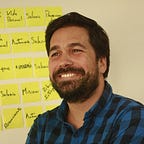Life after seed capital
By the time I was Executive Director at Wingu, our sustainability model was only starting to take shape when we decided to begin our regional expansion. At the moment, we couldn’t really tell if this idea was bold or nonsensical, but the timing seemed right in the Argentine context. The size of the market, the analytics and even our guts told us we should start by Mexico. We knew this represented a financial risk, but we also knew geographical diversification is one of the paths towards self-sustainability. So, we took a leap of faith.
Were we up to the challenge? Today, I can say without hesitating that we were indeed. However, this only became clear 4 years after landing in Mexico, when our major funder, Hewlett Foundation, concluded their financial support. We confirmed our efforts and our quest for self-funding had been successful when 50% of our income in Mexico turned out to be a result of our service offerings.
This brings me to the mixed income model that Wingu has. It’s simple and it works: 50% of the income comes from the supply of products and services for NGOs and governments. The remaining 50% comes from international cooperation, private sector funding and grants and it is used to develop new social tech projects that require an initial boost to be tested and then scaled.
I must confess that when the donor phase-out time comes, anxiety takes a lead role and the temptation to try to extend the grant for one more year is practically unavoidable. Fortunately, this anxiety also brings the magic out. Already proficient teams get even more creative testing each and every idea that may contribute to the self-sustainability model, delivering high-quality work. Combine necessity with purpose and you’ll get the fuel professional and committed teams need to perpetuate their social impact.
It’s been over 10 years since the Wingu adventure started, 5 years since we set foot on Mexico and almost 2 years since we landed in Colombia. I won’t give away any spoilers on our next destination, but I’m happy to share a few lessons learned on how to sustain projects over time. Take note:
- Diversify your income sources to achieve financial independence. Seed capital is a key lever during kick-off phases but it can turn into a dependant income model if it’s not combined with other sustainable income sources.
- Before asking for funds, define and develop the income model that will take over once the initial funding is gone. Showing your impact will be sustained over time is more than good marketing, it is the first step towards thorough planning.
- Launch an individual donor campaign right away. If you’re just starting, even just one recurring donor will make a difference helping pay the bills.
- Find creative sustainability models taking advantage of the unique value your NGO generates. Your insights and your expertise can be translated into income sources to support your programs.
- Be innovatively realistic. Not every idea or program will be a success story, but experimentation will definitely get you closer to cutting-edge projects. Iterate, diversify, fail, learn and start all over again.
- Stop wondering whether being a B-Corp is a better choice. Give the A-NGO option a shot, you might be surprised.
